In March 2021, one year after the outbreak of COVID-19, Iran was just starting its vaccination campaign, which began on February 9, 2021. But most Iranians were warned that they would have to wait until early 2022 due to a vaccine shortage. Over the first twelve months of the pandemic, nearly 1.6 million Iranians were infected and more than 59,000 died. Iran experienced three surges of infections in 2020 – in the spring, summer and fall – that were each deadlier than the previous wave. A fourth wave of the virus began in late March 2021 as Iran was still in the initial phase of its vaccine rollout. The fourth wave peaked on April 14 with 25,582 new infections and then began to recede.
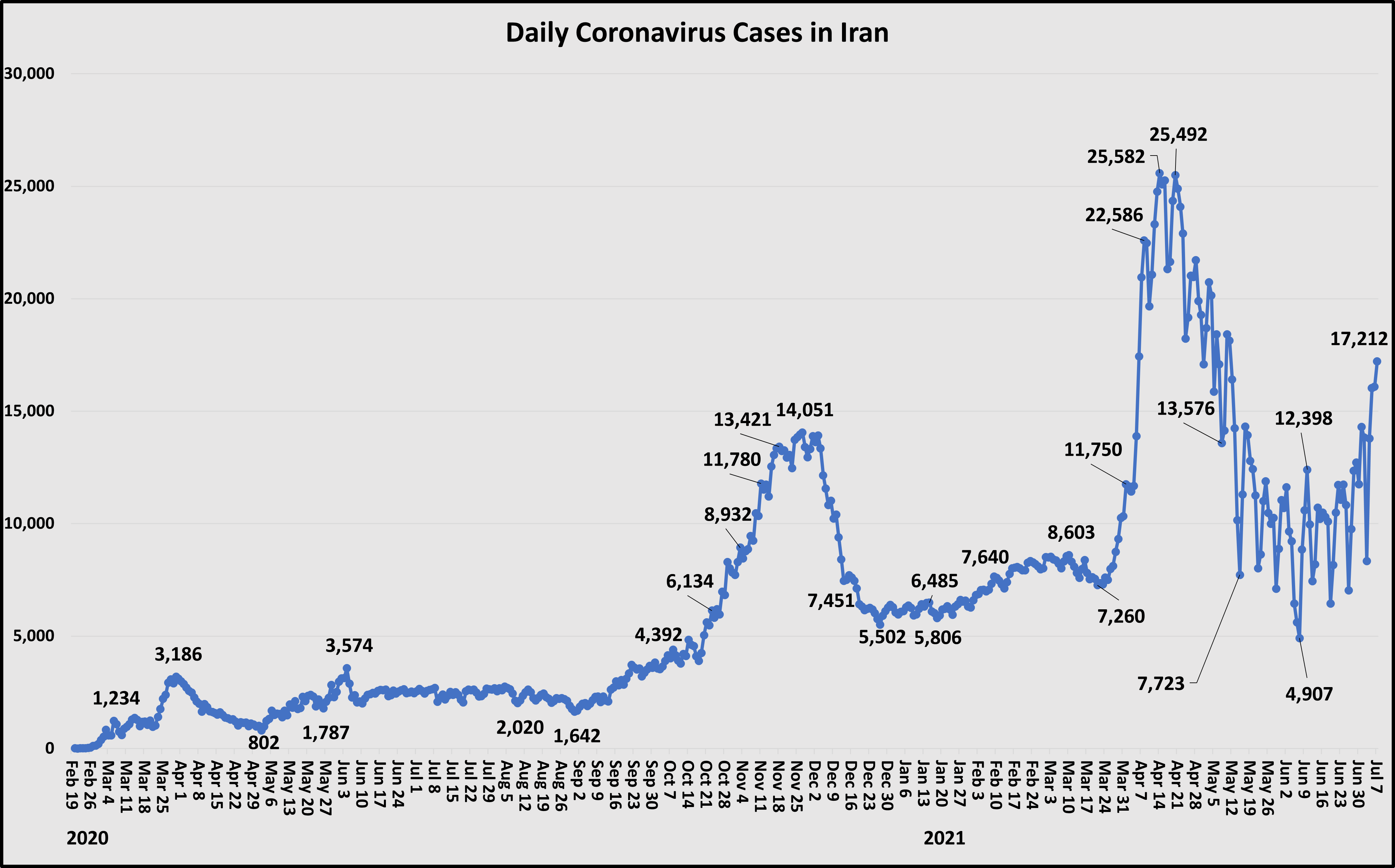
Related Material: Iran Struggles with COVID-19 in 2020
Iran had a vaccine shortage for several reasons, both political and scientific. One setback was self-inflicted. Supreme Leader Ayatollah Ali Khamenei banned all vaccine imports from the United States and Britain, which produced the first viable vaccines. “They’re completely untrustworthy,” he said in a televised speech on January 8, 2021. “It’s not unlikely they would want to contaminate other nations.”
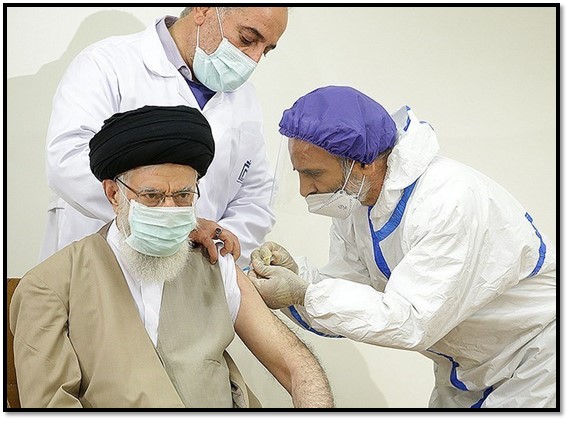
But Iran also lagged behind other industrialized nations in developing its own vaccine. The first domestic vaccine, CovIran Barekat, was not approved for emergency use until June 14. Khamenei received his first shot of CovIran Barekat on June 25. "I did not want to use non-Iranian vaccines, so I said I would wait for the Iranian vaccine," Khamenei said.
In the interim, Tehran turned to Russia, China and Cuba. Russia and China provided hundreds of thousands of doses — Sputnik V and Sinopharm — and Cuban medical companies began joint vaccine testing with Soberana 2. Iran also purchased 16.8 million doses of the COVID-19 vaccine through the World Health Organization’s COVAX program. Humanitarian and medical supplies are exempt from U.S. sanctions. Iran made payment through a Swiss bank.
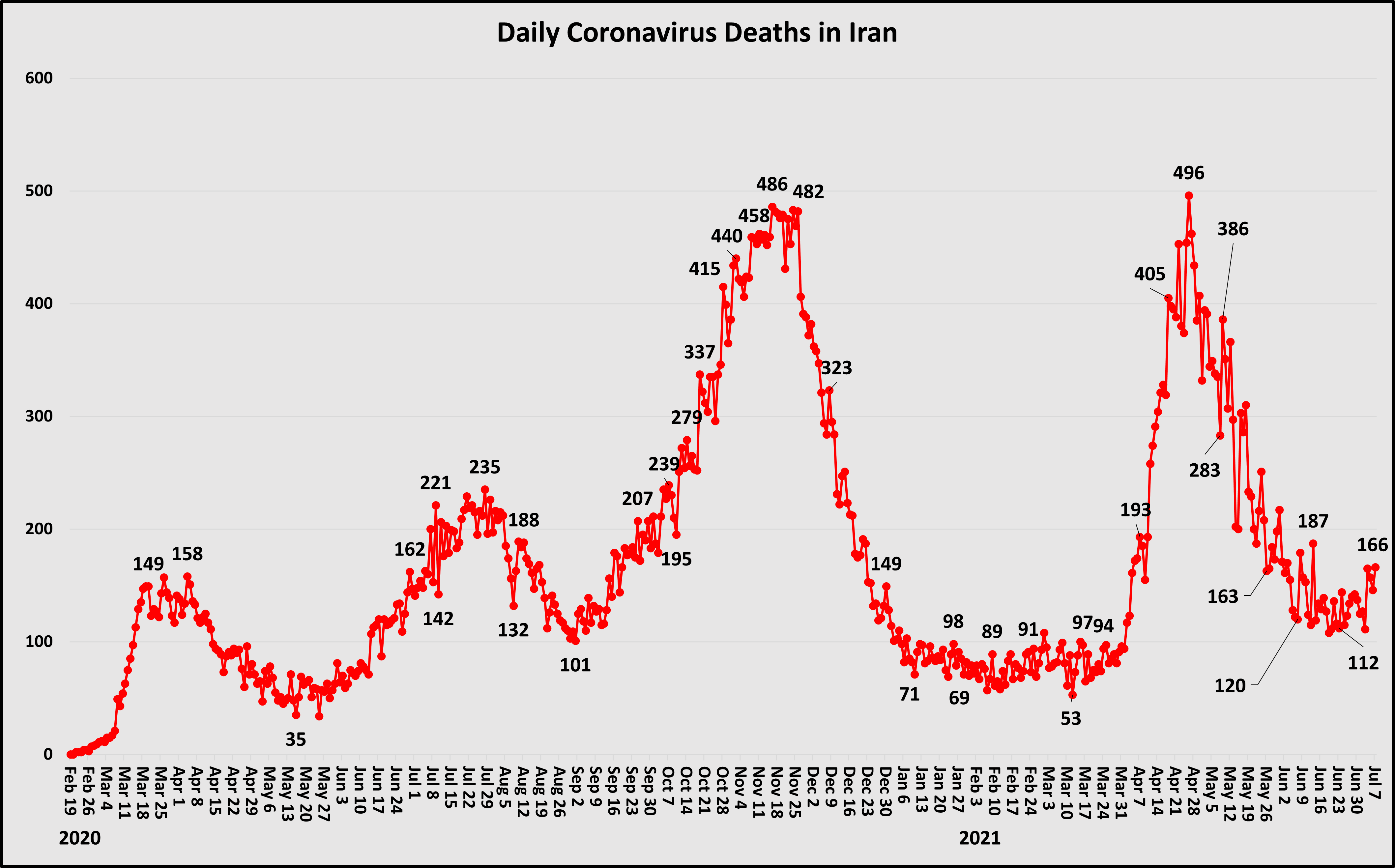
The government prioritized doses for the elderly, health workers, the disabled and war veterans. To boost public confidence in the vaccine, the first dose of the Russian vaccine went to Parsa Namaki, the son of Health Minister Saeed Namaki on February 9, 2021. But President Hassan Rouhani warned that achieving herd immunity would take a “long time” and called on Iranians to remain vigilant in the meantime. “Even after the general vaccination, since none of the vaccines is 100 percent effective, it is necessary to follow the health protocols with complete accuracy,” he said as the rollout began.
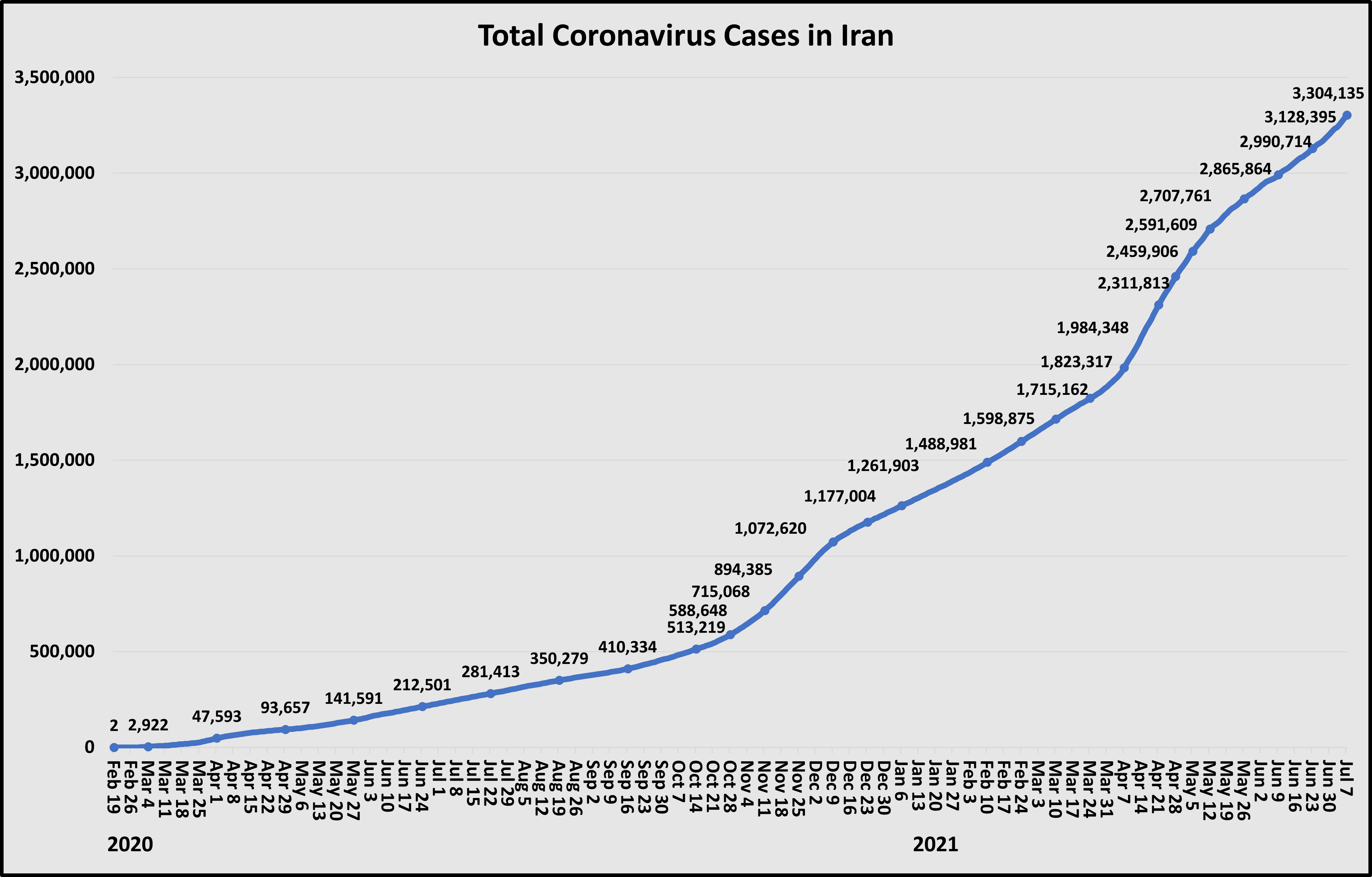
The government also warned about a potential fourth wave of the pandemic after a mutated strain – which originated in Britain and was more infectious than the first strain – was detected in Iran. Health officials said a new surge could be the deadliest yet. “Hard days are beginning for us and you must prepare to fight the most uncontrollable mutated virus,” Namaki said on February 13.
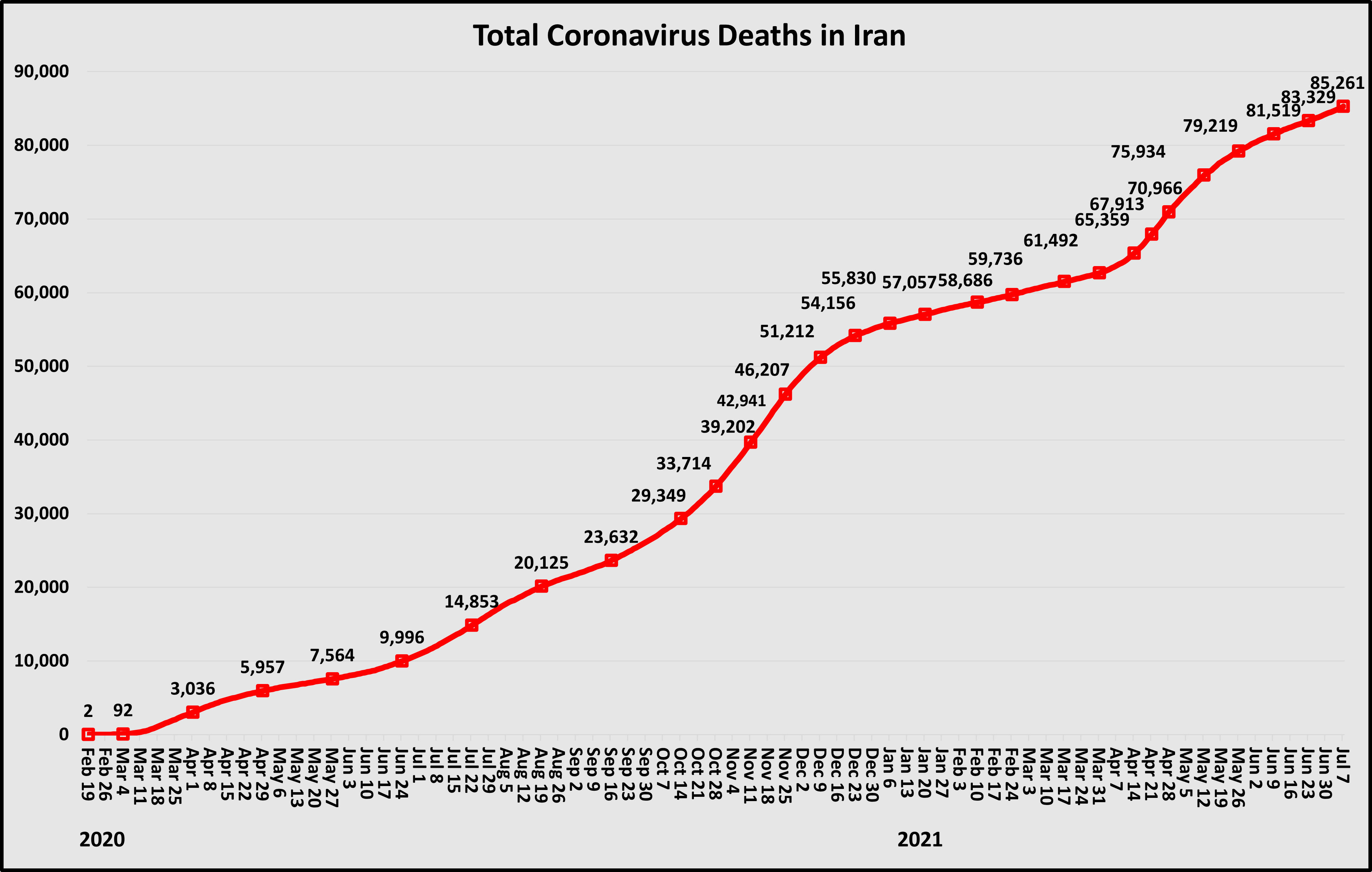
The government took steps to stem the spread of the mutation. On February 28, the government banned flights from 32 countries on four continents, including Europe, Africa, South America and Central America. Rouhani prohibited domestic travel during Nowruz to cities most impacted by the virus; he urged Iranians to stay at home during the Persian New Year. “The start of the vaccination drive in the country should not lead to people considering the situation as normal,” he said on March 6. Rouhani also warned that social distancing measures should continue “for at least one year.”
But many Iranians ignored the travel ban and shopped at crowded bazaars or met in public places. Coronavirus cases spiked sharply during the second week of Nowruz. Road traffic increased by 52 percent compared to Nowruz in March 2020, a month after the first COVID-19 deaths were reported. By April 2021, the number of new infections topped 14,000, higher than during the first two waves of the pandemic. The following is a timeline of the coronavirus outbreak in Iran in 2021.
Related Material:
- One Year of COVID: Economic Impact
- One Year of COVID: Public Opinion
- One Year of COVID: Iran Compared to U.S.
- One Year of COVID: Infected Officials
Timeline of COVID-19 in 2021
Week 47: January 3 – January 9
On January 5, Iran had purchased 16.8 million doses of the COVID-19 vaccine through the World Health Organization’s COVAX program, the Central Bank announced. Funds were routed through a Swiss bank and were exempted from U.S. sanctions.

On January 9, the health ministry said that Iran would receive Cuba’s most advanced coronavirus vaccine. Havana would conduct last-stage clinical trials of its Soberana 2 vaccine on 50,000 Iranian volunteers. “This synergy will enable both countries to advance more rapidly in the immunization against the SARS-CoV-2 virus,” Cuba’s Finlay Vaccine Institute tweeted.
Week 48: January 10 – January 16
On January 10, four cases of the coronavirus variant from Britain were detected in Iran, health officials said. An Iranian family living in Europe had visited Iran and tested positive. The mutated virus was 70 percent more transmissible than previous variants, the government warned.
On January 11, schools in "blue" and "yellow" regions where coronavirus cases were the lowest would reopen on January 20, the Education Ministry said. The directive applied to primary and secondary schools with fewer than 50 students. Vocational schools could resume in-person classes capped at 10 or fewer students.
On January 12, President Rouhani assured Iranians that the government would have enough vaccines to meet domestic demand. “Millions of doses of vaccine have been purchased in that way that would be supplied and the vaccination will be carried out,” he said. Five new cases of the coronavirus variant from Britain were detected in Iran, the health ministry said. Ministry spokesperson Sima Sadat Lari warned that a fourth wave of COVID-19 infections was possible and urged Iranians to continue following strict health protocols.
Week 49: January 17 – January 23
On January 23, vaccines would be administered to high-risk populations within weeks, Rouhani announced. “Foreign vaccines are a necessity until local vaccines are available,” he said in televised remarks. Three domestic vaccines - Barekat, Pasteur and Razi – would not be ready until the spring or early summer.
No Iranian cities remained in the “red” zone, the health ministry said. But widespread violations of social distancing and lockdown measures continued. “There were reports from different cities of numerous cases of failure to comply with the protocols,” Alireza Raisi, the national coronavirus taskforce spokesperson, said.
Week 50: January 24 – January 30
On January 24, Health Minister Namaki recommended strict controls on travel between Iranian cities to prevent spread of the coronavirus variant from Britain. “The new virus is not restricted to Europe and can spread in any climate, even if we control all the ways,” Namaki said. A fourth wave of COVID-19 infections would inflict even greater hardship than previous waves, he warned.
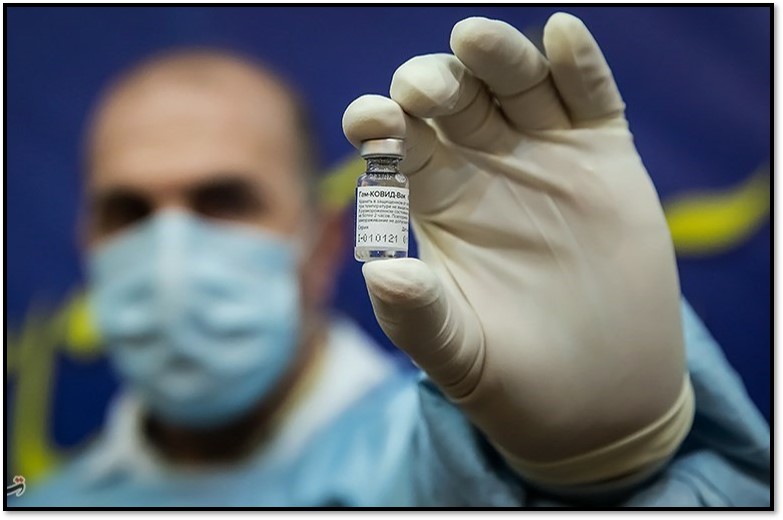
On January 26, Iran approved imports of Russia’s Sputnik V vaccine. “In the near future, we hope to be able to purchase it, as well as start joint production,” Foreign Minister Mohammad Javad Zarif said at a press conference in Moscow. The Russian vaccine was the first foreign vaccine approved for import after Khamenei banned vaccines imported from the United States and Britain on January 8. Iran would begin vaccinating high risk individuals within two weeks, government spokesperson Ali Rabiei said.
Tehran urged President Joe Biden to unfreeze Iranian assets and loosen sanctions to purchase medical and humanitarian goods. “Since [Biden’s] administration claims not to be anti-science like the previous one ... one expects it to free the transfer of Iran’s own foreign exchange resources to fight the coronavirus and for health and food, and lift banking sanctions quickly,” Rabiei said.
On January 28, the Food and Drug Administration of Iran granted emergency authorization for the Russian Sputnik V vaccine. The agency was evaluating other vaccines made in India and China for approval, a spokesperson said.
On January 29, compliance with health safety protocols in Tehran fell from 82 percent to 39 percent, Deputy Health Minister Iraj Harirchi said. The Ministry warned that a “decline in observance of health protocols could lead to a new wave of the disease,” state radio VIRI reported.
On January 30, Iran imposed a two-week quarantine on all travelers arriving from Europe. Even travelers who tested negative would be required to quarantine. Pharmaceutical companies pledged to produce between one and two million does of the homegrown vaccine, known as CovIran Barekat, by the end of March. The Iranian vaccine was effective on the U.K. variant of the virus, health ministry officials said. “Tests have shown that the blood plasma of the people who were injected with the vaccine in human trials is capable of completely defusing the mutated virus of the English corona[virus],” said Hassan Jalili, who oversees production of CovIran Barekat.
Week 51: January 31 – February 6
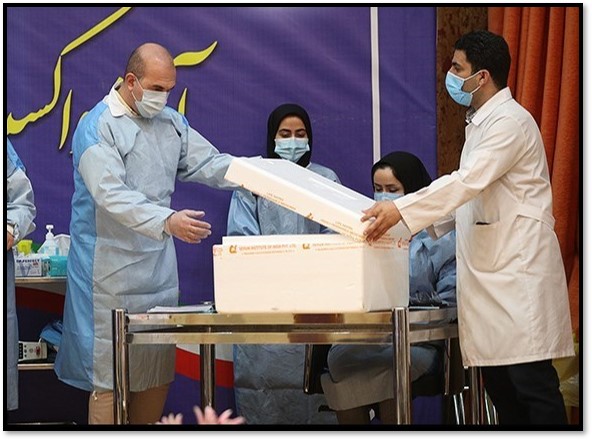
On February 1, the government said that vaccinations for the elderly, health workers, people with disabilities and war veterans would begin in spring 2021. But the government also warned that most Iranians would have to wait until February or March 2022 to be vaccinated.
On February 2, the government said that its domestic vaccine, CovIran Barekat, would be ready by late-April. It planned to produce 12 to 14 million doses each month starting in May.
On February 3, the health ministry said that Iran would receive 4.2 million doses of the AstraZeneca coronavirus vaccine in mid-February. The vaccines were secured through COVAX, the World Health Organization’s vaccine distribution program.
On February 4, Iran received 500,000 doses of the Russian Sputnik V vaccine, the first foreign coronavirus vaccine approved for domestic use. The shipments arrived at Imam Khomeini Airport from Moscow via Mahan Airlines.
On February 5, the second shipment of the Sputnik V vaccine would arrive within two weeks and a third shipment would arrive by February 28, the Iranian ambassador to Moscow said. New shipments would arrive every two weeks after that, he added.
Week 52: February 7 – February 13
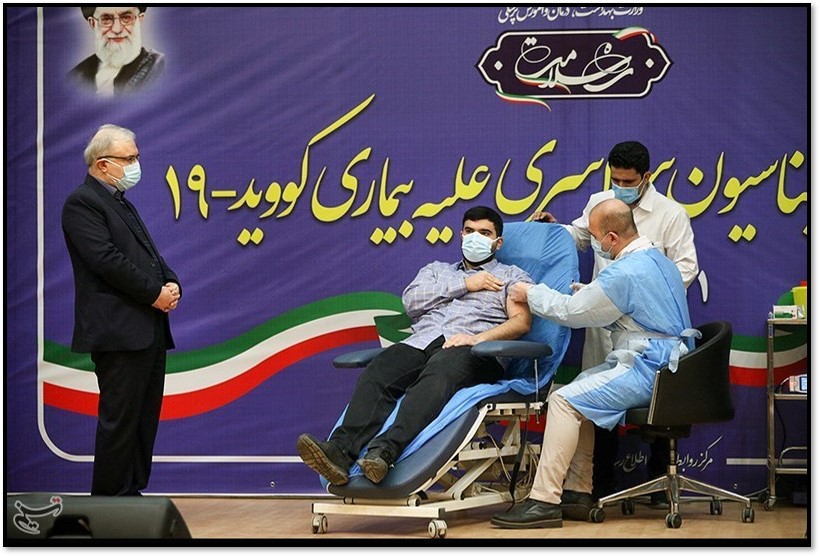
On February 7, Health Minister Namaki said that vaccinations for medical workers would begin on February 9. Doctors and nurse in intensive care units were the top priority. President Rouhani warned that achieving herd immunity would take a “long time” and told Iranians to remain vigilant. “Even after the general vaccination, since none of the vaccines is 100 percent effective, it is necessary to follow the health protocols with complete accuracy,” he said. Iran finished the first phase of human trials for CovIran Barekat, its domestically-produced vaccine. The government would test a second homegrown vaccine, Razi CovPaz, on human volunteers in the coming days.
On February 9, Iran began inoculating health care workers using Russia’s Sputnik V vaccine. Health Minister Namaki’s son was the first person injected, a move designed to boost public confidence in the vaccine. Intensive care unit staff at more than 600 hospitals were also vaccinated.
On February 11, Iran agreed to produce and export Russia's Sputnik V vaccine, Tehran's ambassador to Moscow said. An Iranian delegation visited Moscow to better understand how the Russian vaccine was manufactured.
On February 13, President Rouhani urged stricter testing and quarantine measures at the border to prevent a fourth wave of the coronavirus. The health ministry declared that nine cities -- all in Khuzestan province -- were high-risk "red" zones. “Hard days are beginning for us and you must prepare to fight the most uncontrollable mutated virus which is unfortunately infecting the country,” Health Minister Namaki said.
Week 53: February 14 – February 20
On February 17, Iran claimed that its homegrown vaccine was"100 percent" effective against the British variant of the coronavirus. The government planned to open its first domestic vaccine factory within two weeks. The factory would be able to produce three million doses of CovIran Barekat each month. The government also authorized three other coronavirus vaccines for import: one from India, one from Russia and the Oxford AstraZeneca vaccine.

More than 3,000 doctors and nurses have left Iran since the start of the pandemic, Iran's medical professional organization reported. "When physicians face social, job and welfare tensions, and job insecurity on a daily basis, these all lead them to lose their motivation," said Mohammad Jahangiri, a senior official with the Medical Council of Iran. "When we don’t create motivations and simultaneously there is a need for doctors in other countries, they leave the country."
On February 18, Iran identified 21 cases of the British coronavirus variant. The patients infected were from Tehran, Alborz, Qazvin and Khuzestan provinces. Iran's U.N. envoy called the virus the "common enemy of humanity" and urged wealthier nations to donate vaccine surpluses to poorer nations. “There is no other option but to achieve success in containing the virus,” Ambassador Majid Takht Ravanchi told the Security Council.
On February 19, the government prohibited in-person concerts and cultural events to stem the spread of a new coronavirus variant. "All the concerts can only stream online,” Deputy Health Minister Mohsen Farhadi said. The number of foreign visitors to Iran decreased by 94 percent in 2020, the tourism ministry said. More than 1.5 million jobs had been lost in the travel sector due to the coronavirus.
On February 20, Iran closed its borders with Iraq to prevent the spread of the mutated COVID-19 strain. “The main source of infection ... with the British coronavirus in Khuzestan province were travelers who came from Iraq,” Namaki said. The government closed four entry points at Kileh, Piranshahr, Chazzabeh and Shalamcheh.
Week 54: February 21 – February 27
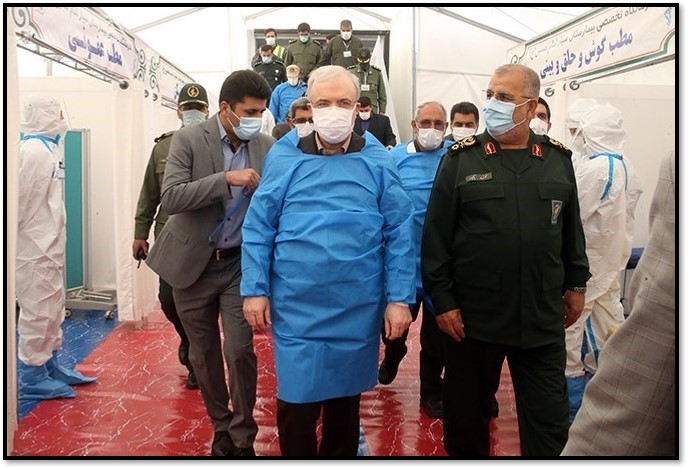
On February 21, Iran claimed that its domestically-produced vaccine was highly effective against the virus. “Preliminary results show that about 90 percent of the people who received two doses of the vaccine exhibit evidence of immunity,” Mohamad Reza Salehi, who heads clinical trials for CovIran Barekat, said.
On February 22, Tehran and Tokyo discussed using frozen Iranian financial assets in Japanese banks to purchase vaccines. The Japanese ambassador in Tehran suggested the move during a meeting with Central Bank of Iran Governor Abdonnaser Hemmati, state media reported.
On February 24, Iran detected 13 new cases of the mutated coronavirus: five in Tehran province, seven in Hormozgan province and one in West Azerbaijan province. A total of 112 patients had been infected with COVID-19 variant and eight had died, the government said. The government closed a fifth border crossing with Iraq at Mehran.
On February 25, infections among children were up 10 percent since last year, the government said. “Two age groups, those under 10 and above 70 are considered high-risk groups," Alireza Zali, head of the Coronavirus Taskforce of Tehran, said. "They need to strictly abide by health protocols.” Iran would import four million vaccine doses by late March, the health ministry said.
On February 27, President Rouhani warned that travel restrictions would remain in place through the Nowruz holidays, which will begin on March 21. The government encouraged Iranians to stay home and abide by health guidelines.
Week 55: February 28 – March 6

On February 28, Iran received 250,000 doses of China's Sinopharm vaccine, the second foreign vaccine imported by Tehran. The government called the donation a "new symbol of friendship" between Tehran and Beijing. “Cooperation in containing the coronavirus once again proved the significance of strategic relations between the two countries,” Foreign Ministry spokesperson Saeed Khatibzadeh tweeted in Mandarin.
The government banned flights from 32 countries to stem the spread of the mutated coronavirus. The list included countries in Africa, South America and Central America that the health ministry had deemed "high risk."
On March 3, the government pledged that it would vaccinate Iranians aged 65 and older by July at the latest. The next priority group after the elderly were Iranians between the ages of 16 and 64 with underlying conditions.
On March 4, Iran received a third shipment of Sputnik V vaccines from Russia. Some 200,000 doses arrived at Imam Khomeini International Airport in Tehran.
On March 5, the government said that one million doses obtained through the WHO’s COVAX program would arrive between March 18 and March 28. Iranians older than 80 and those suffering from underlying illnesses would be prioritized for vaccination.
On March 6, President Rouhani banned travel during Nowruz to all red- or orange-zone cities and urged Iranians to avoid travel in general during the Persian New Year. “The start of the vaccination drive in the country should not lead to people considering the situation as normal,” he said at a meeting of the National Coronavirus Task Force. Rouhani also said that social distancing measures should continue “for at least one year from now due to the many mutations of the virus.”
Week 56: March 7 – March 13
On March 7, the health ministry said that South Korea would import 3.1 million doses of the AstraZeneca vaccine.
On March 9, inoculations using the domestically produced CovIran Barekat vaccine would begin in May, the chairman of Setad said. He assured the public that there was a sufficient supply of vaccines for the next two-and-a-half months.
On March 10, Iran's Food and Drug Administration issued a permit allowing emergency use of China's Sinopharm vaccine. China sent 250,000 doses of the vaccine to Iran on February 28.
On March 11, Iran received 100,000 doses of Cuba's Soberana 2 vaccine, Fars News Agency reported. Tehran had previously allowed Cuba to conduct last-stage clinical trials on 50,000 Iranian volunteers in exchange for doses of the vaccine. Iran also received 150,000 doses of Covaxin, India's vaccine and would receive another 375,000 doses the following week.
On March 13, Rouhani urged Iranians to take special precautions during Nowruz this year. "Considering that we are still dealing with this disease and have not yet reached a reassuring and stable point, this year we must hold the visits with masks and without shaking hands," he said.
Week 57: March 14 – March 20
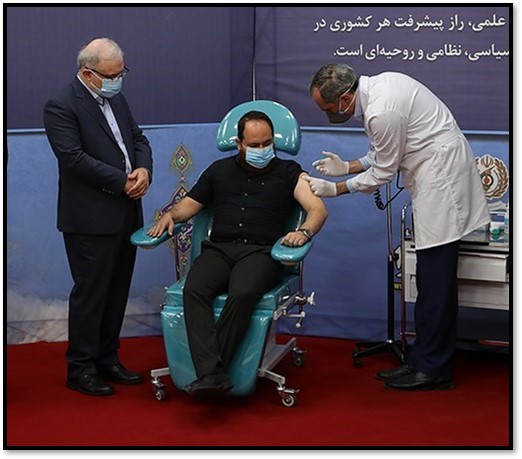
On March 15, the government began mass production of the CovIran Barekat vaccine. Its goal was to initially produce 3 million doses a month and then to scale up to 12 to 15 million doses per month by June, the chairman of Setad said.
On March 16, Iran initiated human trials for a third domestically-produced vaccine, Fakhravac. The vaccine was named after assassinated nuclear scientist Mohsen Fakhrizadeh and developed by his former employer, the Organization of Defensive Innovation and Research. Hamed Fakhrizadeh, Mohsen's son, received the first dose at at an unveiling ceremony in Tehran. The government planned to test the vaccine on 20,000 volunteers.
On March 18, the government extended its ban on flights to and from Britain until May 1. Iran's Civil Aviation Organization had first suspended flights to Britain on December 22, 2020, to prevent the spread of the mutated strain of the coroanvirus. Flights to and from Iraq remained suspended until the end of March.
On March 19, the government assured Iranians that no government official had skipped the line to be vaccinated. President Rouhani's chief of staff, Mahmoud Vaezi, said that only those in priority groups - such as healthcare workers, the elderly and those with underlying medical conditions - had received the vaccine.
Week 58: March 21 – March 27
On March 25, Iran would receive 100,000 additional doses of the Sputnik V vaccine, Tehran's ambassador in Moscow said. Russia had already sent Iran more than 400,000 doses of the vaccine since February 4.
On March 27, Iran was in talks to purchase 10 million doses of the Sputnik V vaccine, Tehran's ambassador to Moscow said. Russia had previously agreed to sell one million doses of its vaccine to Iran.
China pledged to help Iran fight the coronavirus pandemic with additional medical equipment and medicine. "We will provide more COVID-19 vaccine to Iran, and Iran is our priority in this regard," Chinese Foreign Minister Wang Yi said in Tehran.
Week 59: March 28 – April 3
On March 30, Iran said that it would begin mass production of the Fakhra vaccine by late May. Mass production of CovIran Barekat, Iran's first domestically developed vaccine, began on March 15.
Health officials warned that widespread travel during Nowruz may have triggered “A fourth coronavirus wave has definitely begun in many parts of the west and center of the country and is advancing towards the east,” a Health Ministry spokeswoman said.
On March 31, the health ministry declared that it had vaccinated 80 percent of health care workers who dealt with coronavirus patients.
On April 3, President Rouhani warned that the fourth wave of the pandemic had begun in two provinces. "If we do not observe health protocols, this wave will enter other provinces as well," he said at a meeting of the National Coronavirus Task Force. Rouhani promised that the government would prioritize developing and importing vaccines but urged Iranians to quarantine themselves at the first sign of illness. “It is not acceptable for someone who is diagnosed with COVID-19 to go to work or attend meetings, or worse, to travel," he said.
The government restricted travel to and from Turkey to help curb the spread of the mutated coronavirus. All land and air travel was suspended for a week. Iranian citizens living in Turkey could return home if they tested negative.
Week 60: April 4 – April 10
On April 4, the Health Ministry classified Tehran a "red-zone," high-risk city as COVID-19 infections surged in the capital. Hospitalizations increased 37 percent compared to the previous week. Local officials called for tightened health and safety regulations to prevent the further spread of the virus. "What is evident to us for now is that the fourth wave of the pandemic has hit Tehran,” Nader Tavakkoli, an official with the provincial coronavirus task force, said.
officials say Iran is seeing a new wave of covid outbreak, in the absence of mass vaccinations & inefficient restrix that are not properly enforced.
— Hadi Nili (@HadiNili) April 7, 2021
17k+ new cases & 174 deaths just in a day; per OFFICIAL numbers.
(map: red & orange are "very high risk" & "high risk" territories) pic.twitter.com/JzCjrHbDRA
On April 5, more than 700,000 doses of the Oxford/AstraZeneca vaccine - purchased through COVAX - arrived in Iran. The vaccines were produced in South Korea and transported via the Netherlands to comply with the supreme leader's ban on vaccine imports from Britain.
IranAir, the national airliner, announced a special flight on April 11 to bring Iranians living in Britain back home. All passengers older than eight years of age would need to present negative COVID-19 tests before boarding the flight.
On April 6, Iran extended travel restrictions to Iraq for two additional weeks.
On April 7, Iran broke its record for daily infections as new cases reached nearly 21,000. All provincial capitals were categorized as "red zones" with the highest risk of infection. Many had been classified as "blue" or in the lowest risk category during Nowruz, Tasnim News Agency reported. The Health Ministry announced that 85 percent of the country was in a "red" or "orange" zone.
On April 10, the government ordered a 10-day lockdown in 23 of Iran's 31 provinces. All businesses, schools, theater and sports facilities were forced to shutdown. President Rouhani blamed the mutated COVID-19 variant originating in Britain for the spike in cases. The president threatened strict punishments for Iranians who broke health and safety protocols. "Violation of quarantine by infected people is very dangerous and must be dealt with legally," he said.
Week 61: April 11 – April 17
On April 11, the government extended the ban on travel to Iraq until April 20. Only Iranians with education, healthcare, investment or business visas could cross the border.
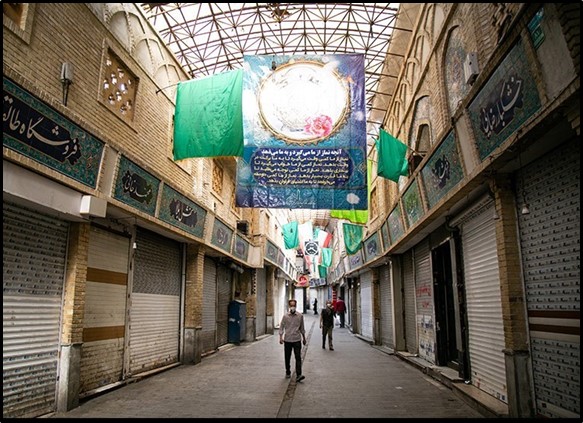
On April 13, Iran would begin mass producing the CovIran Barekat vaccine on April 21, the chairman of Setad said. Iran would prioritize domestic vaccinations before exporting doses abroad, he added.
On April 15, Iran will purchase 60 million doses of Russia's Sputnik V vaccine, the Iranian ambassador to Moscow said. The doses are scheduled to arrive in Iran between May and November, the state-run IRNA news agency reported. Iran received another 400,000 doses of the Sinopharm vaccine donated by the Red Cross Society of China, the government said.
On April 16, Health Minister Namaki said that Iran had administered 500,000 vaccines so far and would administer a total of 1.3 million doses by April 22.
On April 17, President Rouhani urged that Iranians follow "strict, full observance of all health protocols" including hand washing, mask wearing, social distancing and avoiding travel. He pledged that the government would roll out its domestic version of the vaccine by the summer. "The government has done everything in its power to prepare the domestic vaccine sooner...because it is important for us to stand on our own two feet," Rouhani said.
Week 62: April 18 – April 24
On April 18, Iran reported its highest single-day death toll since November as new COVID-19 fatalities surpassed 400. Cuba received approval to begin the third phase of vaccine clinical trials in Iran. Some 50,000 Iranians between the ages of 18 and 80 would receive the Soberana 2 vaccine, Tasnim News Agency reported.

On April 20, the Central Bank said that it had set aside $178 million to purchase vaccines through COVAX. Iran cancelled its annual Qods Day rallies scheduled for May 7, the last Friday of Ramadan, due to the outbreak of the fourth coronavirus wave. The annual event was started by the Islamic Republic in 1979 and is typically marked by government-sponsored protests against Israel. This was the second year in a row that Iran was forced to cancel street rallies for Qods Day.
On April 21, Iran purchased COVID-19 vaccines from South Korea using $30 million frozen in Korean banks, the state-run IRNA reported. In February, South Korea reached a deal with Iran to unlock $7 billion worth of Iranian assets held by two South Korean Banks - Industrial Bank of Korea and Woori Bank. Seoul agreed to use a portion of the frozen assets to pay Iran's United Nations debts and to facilitate trade of medical and humanitarian goods. The funds had been frozen since 2019 after the Trump administration sanctioned Iran's oil sector.
Air travel between Iran and Turkey had decreased by 95 percent in April, Iran's civil aviation organization said. Tehran restricted tourism to Turkey starting on April 3 to mitigate the spread of the fourth wave of the coronavirus.
On April 22, the daily death toll spiked to 453, nearly as high as during the third wave of the pandemic in November. Hospital admissions in Tehran surged, the Associated Press reported. All wards at Shohadaye Tajrish Hospital were reserved for COVID-19 patients, and Imam Khomeini Hospital turned away patients without positive COVID-19 tests. The Behesht-e Zahra cemetery - Tehran's main burial site - buried than 350 bodies in a single day, 150 of which had died from the coronavirus. Iran received 100,000 additional doses of the Sputnik V vaccine, its sixth shipment from Russia since February.
Week 63: April 25 – May 1

On April 25, Iran suspended all flights to and from India and Pakistan over concerns about rising COVID-19 cases. “Now we face a new threat that is the Indian virus, which is worse than the English, Brazilian and South African ones,” President Rouhani said. India was averaging more than 300,000 new cases per day the previous week, more than anywhere else in the world.
On April 27, the government began the second phase of its vaccination campaign. Iranians over the age of 65 and those with underlying health conditions were eligible to receive the vaccine. Iran detected three cases of the South African variant of the coronavirus, the Health Ministry reported.
On April 29, Afghanistan barred entry from Iran through the Islam Qala border but allowed cross-border trade to continue. "This precautionary measure has been taken by the Iranian government due to the increase in the number of coronavirus cases and deaths [in Iran],” the governor of Afghanistan's Herat province said.
On May 1, President Rouhani said that vaccinations of the elderly and those with underlying medical conditions should be completed in two months. "We hope that if the domestic vaccines are provided in the time announced previously, we will be able to see better conditions in business and educational issues in the second half of this year," he said at a meeting of the National Coronavirus Task Force.
Week 64: May 2 – May 8
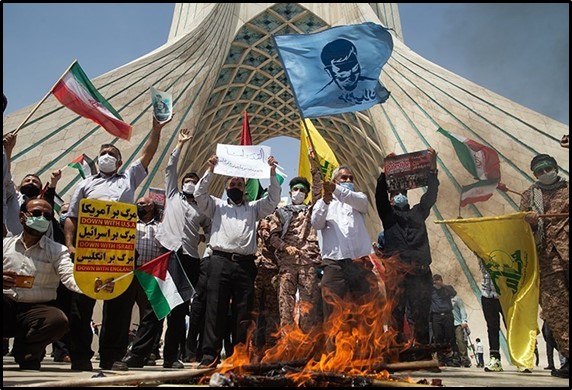
On May 2, Pakistan announced it would temporarily close border crossings with Iran for everyone except Pakistani nationals. The restrictions would go into effect on May 4 and would last until May 20. Iran said that it would pay Russia for COVID-19 vaccine shipments via Iraq. Baghdad would sent funds used to purchase Iranian natural gas and electricity to Russia.
On May 4, Tehran's Food and Drug Administration said that doses of the Sputnik V vaccine produced within Iran would be rolled out within two months, TASS reported.
On May 5, Iran finished the first phase of human trials for its "Fakhra" coronavirus vaccine.
On May 8, the government banned traveling during Eid al Fitr, the religious holiday marking the end of Ramadan. All travel between cities would be prohibited between 2 pm on May 11 and noon on May 15. President Rouhani said that Iran had passed the peak of the fourth wave of the pandemic. “Despite a rise in the number of infections during this surge, the death tally during the fourth wave was fortunately the same as that in the third surge," he said.
Week 65: May 9 – May 15
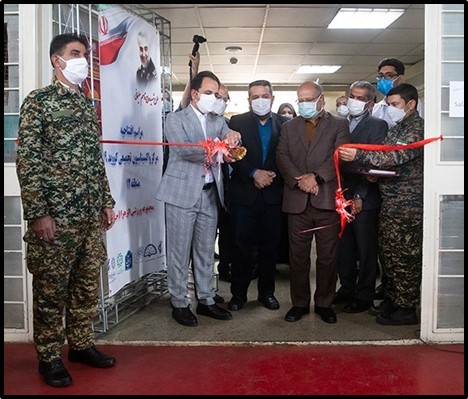
On May 9, President Rouhani set a goal of vaccinating 13 million people, approximately 15 percent of Iran's total population, by July 22. Vaccinations would cover those in the highest-risk group, the president told his cabinet. Iran began vaccinating those over the age of 65 and individuals with underlying health conditions on April 27. "Time should not be lost to save lives and the country's needs should be met by importing vaccines," he said.
On May 10, the Health Ministry announced that Iran would receive 10 million vaccine doses by early June. The government has imported 3.2 million doses of the vaccine from Russia, India, South Korea and China so far.
On May 11, Iran launched mass production of the domestically-produced CovIran Barekat vaccine. The Health Ministry received 300,000 doses from a factory constructed by Setad.
On May 12, Iran resumed flights between its port city of Bandar Abbas and Dubai in the United Arab Emirates. All passengers were required to have tested negative for COVID-19 before boarding the flight.
On May 13, an hardline lawmaker accused the government of losing 200,000 vaccines. Mohsen Dehnavi, a former cancer researcher who won a seat in 2020, said that the health ministry had left a request for the total number of vaccine doses "unanswered." The government denied the charges. "No dose has been or will be unaccounted for," a Food and Drug Administration spokesperson responded on Twitter.
On May 15, President Rouhani declared that no senior government officials had received the COVID-19 vaccine ahead of the general population. "I honestly say that I have not been vaccinated yet because it is not my turn, and I do not know any high-level official in the country that has taken the vaccine except within the framework of the national vaccination document," he said at a weekly meeting of the National Coronavirus Task Force.
Week 66: May 16 – May 22
On May 16, Iran received 1.45 million doses of the AstraZeneca vaccine from the World Health Organization. The government said that it would spend 4 trillion rials ($17.5 million) to import 10 million doses China's Sinopharm vaccine. Health Minister Namaki set a target of vaccinating 13 to 14 million Iranians by the end of June, nearly a full month ahead of the timetable set by President Rouhani.
On May 17, Mir Hossein Mousavi and his wife Zahra Rahnavard - the leaders of the opposition Green Movement - were vaccinated. The pair have been living under house arrest since 2011. Both were older than 75 and were eligible to receive the vaccine under the government's rollout plan.
On May 22, the head of Iran's transportation union warned that at least 15,000 couriers and pickup drivers had lost their jobs due to the pandemic. The number equaled between 50 and 60 percent of drivers working in the transportation sector.
Week 67: May 23 – May 29
Iran stands with Africa, inspired by its triumph against domination.
— Javad Zarif (@JZarif) May 25, 2021
As COVID-19 continues to ravage the world, we're again joined in the fight against apartheid—this time #VaccineApartheid
Iran will always be reliable partner to all African friends.
Congrats on #AfricaDay2021
On May 23, the government said that the fourth wave of the coronavirus had passed and that deaths would decrease in the coming weeks. The National Coronavirus Task Force recommended changes to voting to stem the spread of the coronavirus during Iran's presidential election, scheduled for June 18. “There is no need for using stamps and fingerprinting on the election day,” Alireza Raisi, the taskforce spokesperson, said. Voting should take place in open spaces rather than indoors, and infected patients should be offered mobile ballot boxes rather than voting in person, Raisi added.
On May 26, Iran administered the second dose of the vaccine to individuals with autism. The Health Ministry and the Iran Autism Association began vaccinations for autistic individuals in April.
On May 28, the government said that human trials of CovIran Barekat, Iran's first domestically-produced vaccine, would finish in late June. Iran began the second phase of human trials for its second domestically-produced vaccine - Razi CovPars. The vaccine was administered to 500 people. Only mild side effects, such as headaches and mild fevers, were reported.
On May 29, Tehran and Baghdad agreed to use Iranian funds frozen in Iraqi banks to purchase COVID-19 vaccines. The Trade Bank of Iraq would wire $125 million to a Swiss bank to purchase 16 million doses from COVAX, Iran's minister of energy said. Billions of dollars in Iranian oil revenue were frozen in accounts abroad after the United States reimposed sanctions on Iran's oil sector in 2018.
President Rouhani said domestically-produced vaccines could accelerate the timetable for Iran's inoculation campaign. "If enough vaccines are produced domestically and we buy the required vaccine at the same time, we can start the public vaccination in August and end it until December," he told the National Coronavirus Task Force.
Week 68: May 30 – June 5
On May 31, Iran's Food and Drug Administration said that it would issue authorization for two domestically produced vaccines "over the next few days." Both vaccines - CovIran Barekat and Soberana-02 (jointly developed by Iran and Cuba) - had yet to complete clinical trials. But both vaccines met "acceptable" safety and efficacy standards, agency spokesperson Kianoush Jahanpour said. "We cannot announce the exact efficacy rate before trials conclude but both figures are somewhere between 80 to 90 percent," he said.
On June 2, the Iranian embassy in Moscow received 100,000 more doses of the Sputnik V vaccine and would ship them to Tehran by June 3. Since February, Iran has imported 820,000 doses of the Sputnik V vaccine from Russia.
Week 69: June 6 – June 12
On June 7, Ali Akbar Mohtashamipour, a former member of parliament, died from the coronavirus. He passed away in a hospital in northern Tehran, state-run IRNA reported. Mohtashamipour previously served as ambassador to Syria from 1982 to 1986 and helped establish Hezbollah, a Shiite Islamist militia, in Lebanon. In Parliament, he represented Tehran from 1990 to 1992 and from 2000 to 2004 as a hardliner. But he later joined the reformist faction and supported the opposition Green Movement, which disputed the reelection of President Mahmoud Ahmadinejad in 2009.
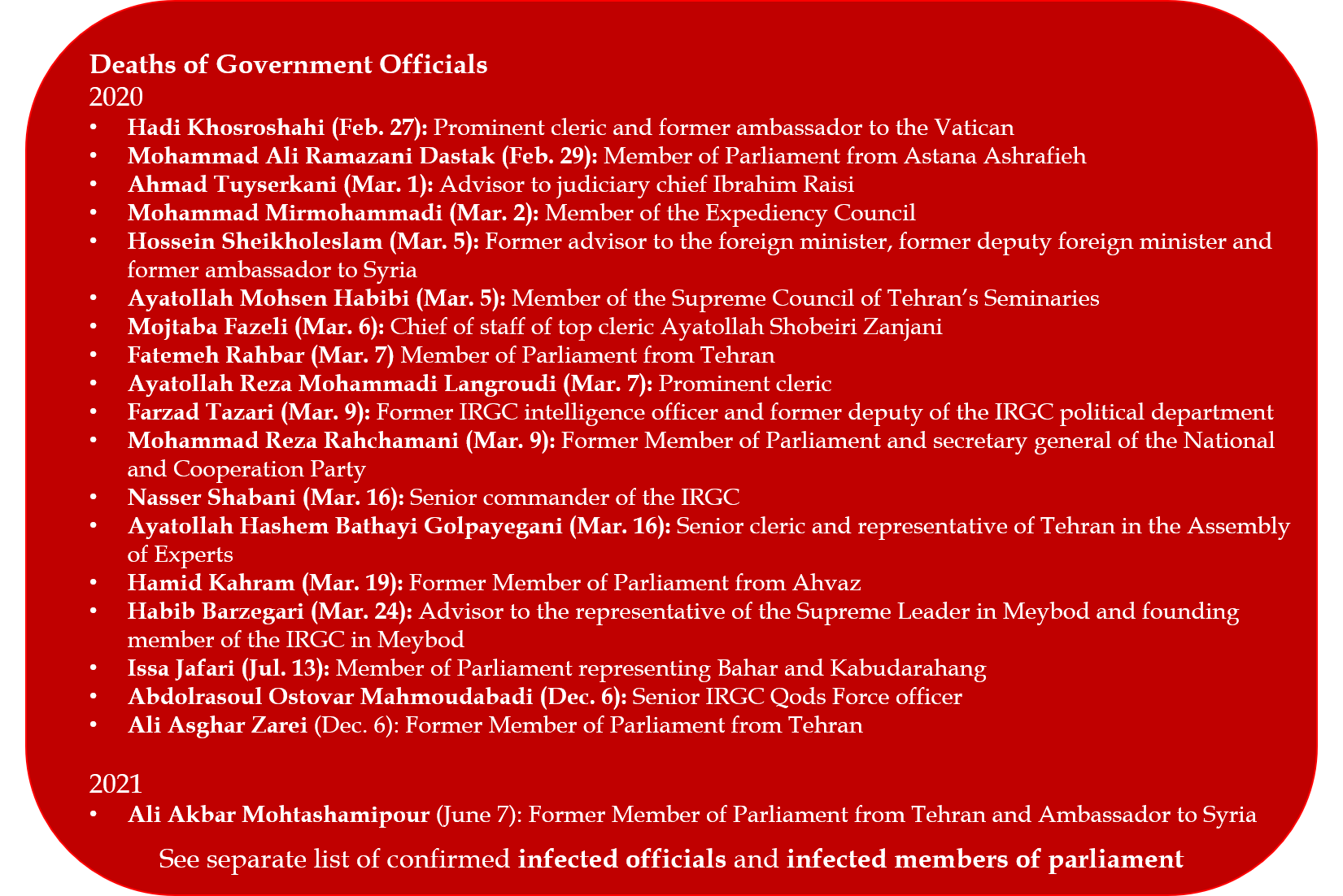
On June 8, the government approved new financial assistance to help businesses affected by the coronavirus, the Tehran Times reported. The package included tax waivers and deferred loan payments. The Iranian embassy in France requested that the government lift the ban on flights from Paris to Tehran. The embassy cited declining infection rates in France.
On June 9, Russia delivered 100,000 more vaccine doses to the Iranian Embassy in Moscow. The vaccines would be transported to Tehran on a Mahan Air flight by June 10. Since February, Iran has imported 900,000 doses of the Sputnik V vaccine from Russia.
Iran initiated the second phase of human trials for its Fakhra vaccine, a domestically-produced inoculation developed by the Ministry of Defense. Some 500 volunteers would receive the vaccine.
Iran's Tourism Ministry said that it had reached an initial agreement with the Foreign Ministry, Health Ministry and Interior Ministry to issue tourist visas by mid-July. "The issuance of tourist visas will resume after the final preparation and approval of travel regulations and protocols," the deputy tourism minister said.
On June 10, some 8,000 volunteers received the first dose of the CovIran Barekat vaccine as part of the third phase of human trials.
Week 70: June 13 – June 19
On June 14, Iran approved emergency use of CovIran Barekat, its first domestically developed vaccine. Health Minister Namaki said that a permit for the second vaccine, Razi CovPars, would be issued the following week. "The entire target population of Iran will be vaccinated by the end of coming fall,” he said.
On June 16, Al Jazeera reported on how the coronavirus had affected the presidential election. The government limited indoor gatherings to 15-30 people and mandated that large rallies could only be held outdoors. Election authorities increased the number of voting booths and placed them outdoors for Friday's vote.
Week 71: June 20 – June 26
On June 20, the Soberana 2 vaccine - which Iran is helping Cuba to test and produce - demonstrated a 62 percent efficacy rate with two of its three doses. Cuba expected an even higher efficacy rate in test subjects who receive the third shot, said the director of the state-run Finlay Vaccine Institute.
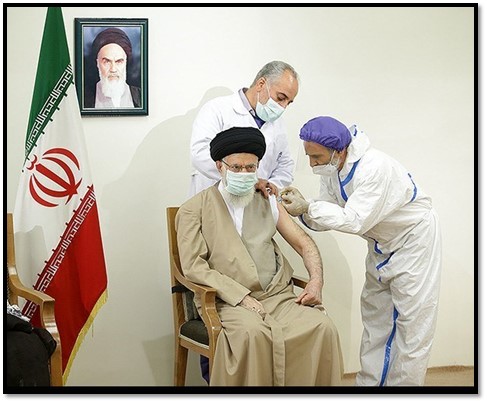
On June 22, President-elect Ebrahim Raisi pledged to procure more vaccinations once in office. "The quickest general vaccination...will be among our immediate programs from the first day of the government," he said in a speech in Mashhad. Raisi said that his government would procure more domestically-produced vaccines as well as "if necessary, those produced abroad."
On June 25, Supreme Leader Khamenei received his first shot of the domestically-produced CovIran Barekat vaccine. The supreme leader's office said that he had two conditions for being vaccinated: he did not want to receive his shot out of turn, and he would receive a domestically-made vaccine. "I did not want to use non-Iranian vaccines, so I said I would wait for the Iranian vaccine," Khamenei, who is 82, said. Iranians over the age of 80 became eligible for vaccination in March.
Khamenei had previously banned all vaccine imports from the United States and Britain, which produced the first viable vaccines. The supreme leader added that using foreign vaccines from Russia and China was "not a problem" but urged people to "respect the Iranian vaccine and thank all the young scientists who worked hard and actively in the production."
On June 27, the Revolutionary Guards unveiled the Noura vaccine, the second vaccine affiliated with the Iranian military. The vaccine was developed by Baqiyatallah University of Medical Sciences, a public university that is the "primary medical institution" for the Revolutionary Guards, according to the U.S. Treasury. Lab tests on mice, rabbits and monkeys were successful, and human clinical trials would begin immediately, state-run IRNA reported.
Week 72: June 27 – July 3
On June 30, a second Iranian vaccine – PastuCovac/Soberana-2 – was approved for emergency use, the health ministry said. The vaccine, codeveloped by Cuba and Iran, was 62 percent effective against new COVID-19 variants, the Tehran Times reported.
On July 1, President Rouhani urged Iranians to fully comply with health protocols to avoid a fifth wave of the coronavirus. He warned that failure to do so would require the government to "impose severe restrictions again." The president added that "in no way" should any foreign nationals infected with the coronavirus be allowed to enter Iran.
On July 2, the government banned entry for travelers from 12 countries to prevent the spread of the coronavirus and its more infectious delta variant. The affected countries were Botswana, Brazil, Eswatini, India, Lesotho, Malawi, Mozambique, Nepal, South Africa, Uruguay, Zambia and Zimbabwe. The travel ban would go into effect on July 4.
On July 3, President Rouhani warned that the COVID delta variant was spreading throughout Iran, particularly in the southern provinces. More than 90 counties were classified as "red" or high-risk zones. "If the health protocols in these areas are not followed, the number of red cities in the country will increase," the president told the National Coronavirus Task Force.
Rouhani attributed the rise in cases to public gatherings during presidential and local elections on June 18. "Despite warnings in recent weeks, during the elections, especially in the council elections, the measures taken were not in line with health protocols," he said. Rouhani added that all Iranians had to follow public health guidelines through the end of the year, "whether people have been vaccinated or not."
Week 73: July 4 – July 10
#COVID19 #Iran:
— Slovenia in Iran (@sloiniran) July 4, 2021
The number of #COVID19 cases is increasing again in 🇮🇷. Provinces, predominantly in the SE and SW are classified as high risk and are red-coded (including #Tehran) as the more contagious Delta virus variant spreads rapidly across the country. pic.twitter.com/ZMwYkGeFcG
On July 4, the government banned travel between cities with high COVID-19 infection rates and reimposed a lockdown of all non-essential businesses in 275 cities, including Tehran. The lockdown affected "all public parks, restaurants, dessert shops, beauty salons, malls and bookstores" in cities classified as "red" or "orange," the Associated Press reported. New coronavirus infections rose 13.2 percent over the previous week, a health ministry spokesperson said.
On July 5, an ethnic Baluch lawmaker accused Afghan migrants of bringing the delta coronavirus variant to Iran, the Tehran Times reported. "In the wake of rising violence in Afghanistan, the number of migrants to Sistan and Baluchistan (province) has increased," parliamentarian Esmail Hossein-Zehi said. "Unfortunately, a majority of the people enter the country without observing health protocols."
On July 7, the intelligence ministry said that it had disbanded a vaccine smuggling network and arrested its members. The network had illegally purchased, sold and distributed foreign vaccines, including Sinopharm, AstraZeneca and Pfizer, state-run IRNA reported.
On July 8, a lawmaker warned that domestic vaccine production would not be sufficient for Iran's entire population. "Three million doses of [CovIran] Barekat vaccine and about one and a half million doses of Pasteur vaccine per month is not a significant number," said Jalil Mirmohammadi Meibodi, who sits on the parliamentary health commission. He advised the government to increase vaccine imports from abroad. "We need to vaccinate 60 million people, so we need 120 million doses of vaccine at present."
Iranian officials rejected media claims that its domestic vaccine production had been sabotaged by the United States. "The news of U.S. sabotage is not true... the production line of CovIran Barakat is operating with full capacity," Shifapharmed Industrial Group, a state-funded biotechnical group involved in manufacturing vaccines. Mohammad Marandi, a hardline media pundit, had reportedly claimed that COVID-19 vaccines had "been delayed due to an American hostile act," the Tehran Times reported in a tweet. Marandi later said that he had been misquoted and the Tehran Times deleted the tweet.
On July 10, the health ministry said that Iran would import six million more coronavirus vaccine doses by July 23. The vaccines would come from "China, Norway and Japan" as well as "other official sources," a health ministry official said.
President Rouhani warned that "despite all efforts" the COVID-19 delta variant had "penetrated deep" into Iran. "The situation is more unfavorable than in previous weeks," he told the National Coronavirus Task Force. Rouhani said that only 66 percent of people were complying with health protocols and that 85 percent compliance was required to get the virus under control. "We ask people to follow the protocols so that we can get through these difficult conditions."
Week 74: July 11 – July 17
On July 11, Iran had imposed flight restrictions on flights to 39 countries, the civil aviation authority said. Iranians could not enter those countries without presenting a negative COVID-19 test before and after arrival.
Thousands of Iranians have traveled to Armenia to get vaccinated, The New York Times reported. Tickets between the two capitals were sold out through late August. Videos on social media showed lines of cars at the border, some waiting 13 hours to cross.
On July 12, the European Union donated $17.7 million (15 million euros) to Iran to help with COVID-19 relief efforts and hosting of Afghan refugees. The funds will go to humanitarian organizations, as well as provide Iran with "urgent medical equipment," the European Commission said in a statement.
As of July 13, some 425 taxi drivers have died from the coronavirus, Iran International reported. One taxi driver estimated that 40 to 50 drivers in Tehran died from COVID-19 each month in 2021.
